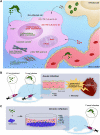Extracellular Vesicles: Potential Role in Remote Signaling and Inflammation in Trypanosoma cruzi-Triggered Disease
- PMID: 34988085
- PMCID: PMC8721122
- DOI: 10.3389/fcell.2021.798054
Extracellular Vesicles: Potential Role in Remote Signaling and Inflammation in Trypanosoma cruzi-Triggered Disease
Abstract
Extracellular vesicles (EVs) act as cell communicators and immune response modulators and may be employed as disease biomarkers and drug delivery systems. In infectious diseases, EVs can be released by the pathogen itself or by the host cells (infected or uninfected), potentially impacting the outcome of the immune response and pathological processes. Chagas disease (CD) is caused by infection by the protozoan Trypanosoma cruzi and is the main cause of heart failure in endemic areas. This illness attracted worldwide attention due to the presence of symptomatic seropositive subjects in North America, Asia, Oceania, and Europe. In the acute phase of infection, nonspecific signs, and symptoms contribute to miss diagnosis and early etiological treatment. In this phase, the immune response is crucial for parasite control; however, parasite persistence, dysregulated immune response, and intrinsic tissue factors may contribute to the pathogenesis of chronic CD. Most seropositive subjects remain in the indeterminate chronic form, and from 30 to 40% of the subjects develop cardiac, digestive, or cardio-digestive manifestations. Identification of EVs containing T. cruzi antigens suggests that these vesicles may target host cells and regulate cellular processes and the immune response by molecular mechanisms that remain to be determined. Parasite-released EVs modulate the host-parasite interplay, stimulate intracellular parasite differentiation and survival, and promote a regulatory cytokine profile in experimental models of CD. EVs derived from the parasite-cell interaction inhibit complement-mediated parasite lysis, allowing evasion. EVs released by T. cruzi-infected cells also regulate surrounding cells, maintaining a proinflammatory profile. After a brief review of the basic features of EVs, the present study focuses on potential participation of T. cruzi-secreted EVs in cell infection and persistence of low-grade parasite load in the chronic phase of infection. We also discuss the role of EVs in shaping the host immune response and in pathogenesis and progression of CD.
Keywords: Chagas disease; Trypanosoma cruzi; extracellular vesicles; immune response; inflammation.
Copyright © 2021 Dantas-Pereira, Menna-Barreto and Lannes-Vieira.
Conflict of interest statement
The authors declare that the research was conducted in the absence of any commercial or financial relationships that could be construed as a potential conflict of interest.
Figures



Similar articles
-
Trypanosoma cruzi interaction with host tissues modulate the composition of large extracellular vesicles.Sci Rep. 2024 Feb 29;14(1):5000. doi: 10.1038/s41598-024-55302-3. Sci Rep. 2024. PMID: 38424216 Free PMC article.
-
Extracellular vesicles of Trypanosoma cruzi and immune complexes they form with sialylated and non-sialylated IgGs increase small peritoneal macrophage subpopulation and elicit different cytokines profiles.Front Immunol. 2023 Aug 2;14:1215913. doi: 10.3389/fimmu.2023.1215913. eCollection 2023. Front Immunol. 2023. PMID: 37600828 Free PMC article.
-
Impact of the Extracellular Vesicles Derived From Trypanosoma cruzi: A Paradox in Host Response and Lipid Metabolism Modulation.Front Cell Infect Microbiol. 2021 Oct 28;11:768124. doi: 10.3389/fcimb.2021.768124. eCollection 2021. Front Cell Infect Microbiol. 2021. PMID: 34778110 Free PMC article. Review.
-
New Biomarker in Chagas Disease: Extracellular Vesicles Isolated from Peripheral Blood in Chronic Chagas Disease Patients Modulate the Human Immune Response.J Immunol Res. 2021 Jan 11;2021:6650670. doi: 10.1155/2021/6650670. eCollection 2021. J Immunol Res. 2021. PMID: 33506056 Free PMC article.
-
The Complement System: A Prey of Trypanosoma cruzi.Front Microbiol. 2017 Apr 20;8:607. doi: 10.3389/fmicb.2017.00607. eCollection 2017. Front Microbiol. 2017. PMID: 28473804 Free PMC article. Review.
Cited by
-
Multi-therapeutic strategy targeting parasite and inflammation-related alterations to improve prognosis of chronic Chagas cardiomyopathy: a hypothesis-based approach.Mem Inst Oswaldo Cruz. 2022 Mar 23;117:e220019. doi: 10.1590/0074-02760220019. eCollection 2022. Mem Inst Oswaldo Cruz. 2022. PMID: 35320825 Free PMC article.
-
RNA-containing extracellular vesicles in infection.RNA Biol. 2024 Jan;21(1):37-51. doi: 10.1080/15476286.2024.2431781. Epub 2024 Nov 26. RNA Biol. 2024. PMID: 39589334 Free PMC article. Review.
-
Identification and characterization of extracellular vesicles from red cells infected with Babesia divergens and Babesia microti.Front Cell Infect Microbiol. 2022 Oct 7;12:962944. doi: 10.3389/fcimb.2022.962944. eCollection 2022. Front Cell Infect Microbiol. 2022. PMID: 36275032 Free PMC article.
-
Biogenesis of extracellular vesicles in protozoan parasites: The ESCRT complex in the trafficking fast lane?PLoS Pathog. 2023 Feb 23;19(2):e1011140. doi: 10.1371/journal.ppat.1011140. eCollection 2023 Feb. PLoS Pathog. 2023. PMID: 36821560 Free PMC article. Review.
-
Molecular Recognition of Surface Trans-Sialidases in Extracellular Vesicles of the Parasite Trypanosoma cruzi Using Atomic Force Microscopy (AFM).Int J Mol Sci. 2022 Jun 28;23(13):7193. doi: 10.3390/ijms23137193. Int J Mol Sci. 2022. PMID: 35806197 Free PMC article.
References
-
- Abuin G., Colli W., Alves M. J. (1996). Turnover and Shedding of the Tc-85 Surface Glycoprotein of Trypanosoma Cruzi Trypomastigotes. Braz. J. Med. Biol. Res. 29 (3), 335–341. - PubMed
-
- Aliberti J. C., Cardoso M. A., Martins G. A., Gazzinelli R. T., Vieira L. Q., Silva J. S. (1996). Interleukin-12 Mediates Resistance to Trypanosoma Cruzi in Mice and Is Produced by Murine Macrophages in Response to Live Trypomastigotes. Infect. Immun. 64 (6), 1961–1967. 10.1128/iai.64.6.1961-1967.1996 - DOI - PMC - PubMed
Publication types
LinkOut - more resources
Full Text Sources

